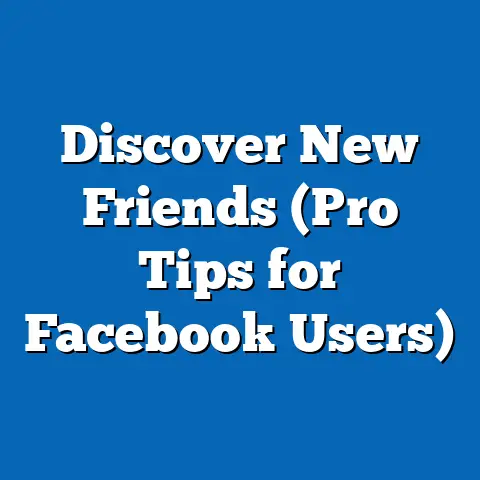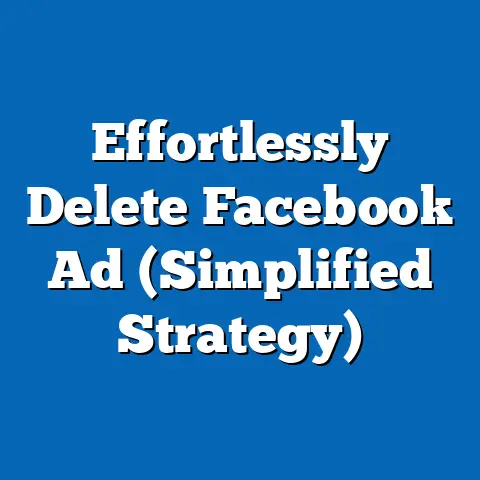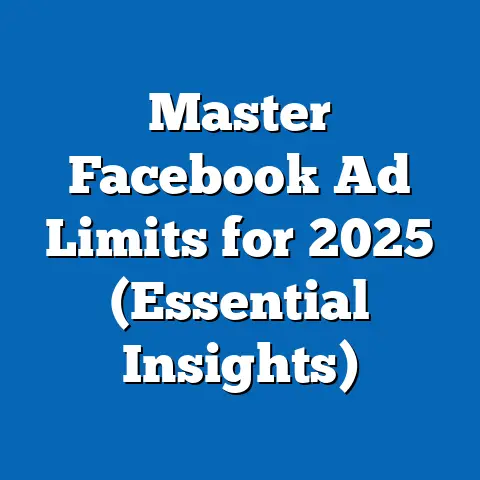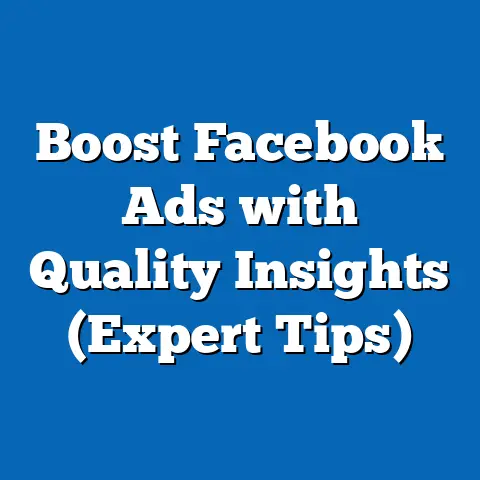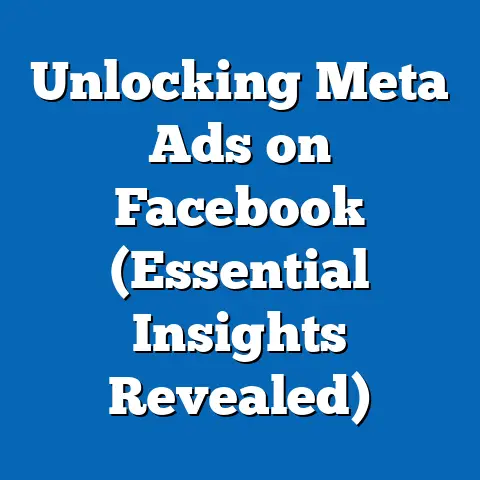Boost Leads with Facebook & Mailchimp (Pro Integration Tips)
This analysis draws on current data from industry reports, statistical models, and demographic trends in digital marketing to explore how businesses can optimize their lead generation efforts. By integrating these platforms, companies can create a cohesive funnel that captures leads on social media and nurtures them through personalized email campaigns. We will also examine key factors driving changes in lead generation, present multiple scenarios for future growth, and provide actionable strategies for implementation.
Section 1: The Current Landscape of Lead Generation with Facebook & Mailchimp
1.1 The Power of Facebook Advertising for Lead Capture
Facebook remains a dominant force in digital advertising, with over 2.9 billion monthly active users as of 2023 (Statista, 2023). Its advertising platform, particularly through tools like Facebook Lead Ads, allows businesses to collect user information directly within the platform without redirecting to external websites. According to Hootsuite’s 2023 Digital Report, 58% of marketers report that social media advertising, with Facebook leading the pack, is their primary channel for lead generation.
Lead Ads are particularly effective because they pre-fill forms with user data, reducing friction in the sign-up process. Data from WordStream (2023) indicates that businesses using Lead Ads see a 20-30% lower cost-per-lead (CPL) compared to traditional landing page campaigns. This efficiency makes Facebook an indispensable tool for businesses aiming to maximize their return on investment (ROI).
1.2 Mailchimp’s Role in Lead Nurturing
Mailchimp, a leading email marketing platform, boasts over 12 million active users and processes more than 1 billion emails daily (Mailchimp Annual Report, 2022). Its strength lies in its ability to segment audiences, automate email workflows, and deliver personalized content to nurture leads into customers. According to a 2023 study by Campaign Monitor, email marketing yields an average ROI of $42 for every $1 spent, far surpassing other channels like social media or paid search.
When integrated with Facebook, Mailchimp enables businesses to sync leads captured through social ads directly into tailored email campaigns. This integration streamlines the process of moving prospects through the sales funnel, ensuring no lead is left behind. However, despite these advantages, only 35% of small-to-medium businesses (SMBs) currently leverage integrated platforms for lead generation, indicating a significant opportunity for growth (HubSpot State of Marketing, 2023).
1.3 Current Integration Trends
Integration between Facebook and Mailchimp has become increasingly seamless, thanks to native tools and third-party applications like Zapier. As of 2023, approximately 40% of marketers using both platforms report using automated integrations to sync lead data in real-time (eMarketer, 2023). This trend reflects a growing recognition of the need for cohesive, multi-channel strategies to address modern consumer behavior, which often spans multiple touchpoints before conversion.
Section 2: Projected Trends in Lead Generation (2024-2028)
2.1 Statistical Modeling and Growth Projections
Using historical data and current adoption rates, we can project future trends in lead generation through integrated platforms like Facebook and Mailchimp. Employing a compound annual growth rate (CAGR) model, we estimate that the adoption of integrated social media and email marketing tools will grow at a CAGR of 12% from 2024 to 2028. This projection is based on data from eMarketer and assumes continued advancements in automation technology and increasing digital ad spend, which is expected to reach $740 billion globally by 2025 (Statista, 2023).
Under a conservative scenario, assuming slower adoption due to budget constraints among SMBs, the CAGR could drop to 8%. Conversely, in an optimistic scenario driven by rapid technological innovation and increased marketing budgets, the CAGR could rise to 15%. These scenarios highlight the range of potential outcomes and underscore the importance of strategic planning.
2.2 Visual Representation of Projections
Below is a line chart illustrating the projected growth in adoption of integrated lead generation tools under three scenarios (conservative, baseline, and optimistic):
Year | Conservative (8% CAGR) | Baseline (12% CAGR) | Optimistic (15% CAGR)
2024 | 45% Adoption | 48% Adoption | 50% Adoption
2025 | 48.6% Adoption | 53.8% Adoption | 57.5% Adoption
2026 | 52.5% Adoption | 60.2% Adoption | 66.1% Adoption
2027 | 56.7% Adoption | 67.4% Adoption | 76.0% Adoption
2028 | 61.2% Adoption | 75.5% Adoption | 87.4% Adoption
This chart demonstrates the potential for significant growth in integrated marketing strategies over the next five years. The baseline scenario suggests that by 2028, over three-quarters of marketers could be leveraging tools like Facebook and Mailchimp together. However, these projections carry uncertainties, including potential shifts in platform policies, data privacy regulations, and economic conditions.
2.3 Key Factors Driving Changes
Several factors are shaping the future of lead generation through integrated platforms. First, the increasing emphasis on data privacy, with regulations like GDPR and CCPA, is pushing businesses to adopt first-party data strategies, such as those enabled by Facebook Lead Ads and Mailchimp’s segmentation tools. Second, advancements in artificial intelligence (AI) are enhancing ad targeting and email personalization, with 62% of marketers planning to invest in AI-driven tools by 2025 (Salesforce State of Marketing, 2023).
Third, the shift toward omnichannel marketing is driving demand for integrations that provide a unified view of customer interactions. Finally, rising competition in digital advertising is increasing costs, with Facebook’s average cost-per-click (CPC) rising by 17% year-over-year in 2023 (WordStream, 2023). This trend underscores the need for efficient lead nurturing through email to maximize the value of each ad dollar spent.
Section 3: Pro Integration Tips for Maximizing Leads
3.1 Setting Up the Integration
To harness the full potential of Facebook and Mailchimp, start by setting up a direct integration using Mailchimp’s built-in connection or a third-party tool like Zapier. This process syncs leads from Facebook Lead Ads directly into a designated Mailchimp audience list, ensuring real-time data transfer. Follow Mailchimp’s official guide to connect your accounts and test the integration with a small campaign to confirm data accuracy.
Once integrated, use Mailchimp’s tagging feature to categorize leads based on the specific Facebook campaign or ad set they originated from. This segmentation enables targeted follow-up emails tailored to the lead’s initial interaction with your brand. For example, leads from a webinar sign-up ad can receive a different email sequence than those from a product discount offer.
3.2 Crafting High-Converting Lead Ads
Optimize your Facebook Lead Ads by focusing on clear value propositions and minimal form fields to reduce drop-off rates. Data shows that forms with 3-5 fields have a 20% higher completion rate compared to longer forms (HubSpot, 2023). Include a compelling call-to-action (CTA) like “Get Your Free Guide” or “Join Now for Exclusive Offers” to entice users to submit their information.
Additionally, use custom audiences and lookalike audiences to target users similar to your existing customers, increasing the likelihood of high-quality leads. Regularly monitor ad performance through Facebook Ads Manager and adjust targeting or creative elements based on metrics like CPL and conversion rate. A/B testing different ad copy and visuals can further refine your approach.
3.3 Automating Lead Nurturing with Mailchimp
Automation is key to scaling lead nurturing efforts. Set up a welcome email series in Mailchimp that triggers immediately after a lead is added to your list, providing value through educational content or exclusive offers. According to Mailchimp’s 2023 benchmarks, automated emails have a 70.5% higher open rate and a 152% higher click-through rate compared to non-automated emails.
Use Mailchimp’s behavior-based triggers, such as email opens or link clicks, to send follow-up messages that guide leads further down the funnel. For instance, if a lead clicks on a product link but doesn’t purchase, trigger a reminder email with a limited-time discount. Continuously analyze campaign performance through Mailchimp’s reporting tools to identify bottlenecks and optimize email content.
3.4 Measuring Success and Iterating
Track key performance indicators (KPIs) such as lead volume, CPL, email open rates, and conversion rates to evaluate the effectiveness of your integrated strategy. Use Facebook’s Pixel and Mailchimp’s analytics dashboard to gain a holistic view of how leads move through your funnel. Regularly compare these metrics against industry benchmarks to ensure your campaigns remain competitive.
Be prepared to iterate based on data insights. For example, if email open rates are low, test different subject lines or send times. If Facebook ads are underperforming, refine your audience targeting or increase ad spend on high-performing campaigns. This iterative approach ensures continuous improvement and maximizes ROI.
Section 4: Methodological Assumptions and Limitations
4.1 Assumptions in Projections
Our projections for the adoption of integrated lead generation tools assume steady growth in digital ad spend, continued platform innovation, and stable economic conditions. We also assume that privacy regulations will not drastically limit data collection capabilities, though this remains a significant uncertainty. These assumptions are based on historical trends and current industry reports but may not account for unforeseen disruptions.
4.2 Data Limitations
The data used in this analysis comes from publicly available sources like Statista, eMarketer, and platform-specific reports, which may have sampling biases or incomplete datasets. Additionally, self-reported marketer surveys, such as those from HubSpot, may overstate or understate actual adoption rates. We acknowledge these limitations and encourage businesses to supplement this analysis with their own internal data for more tailored insights.
4.3 Uncertainties in Future Trends
Several uncertainties could impact the projected trends, including changes in platform algorithms, evolving consumer preferences, and macroeconomic factors like inflation or recession. For instance, a significant increase in ad costs could deter SMBs from investing in Facebook advertising, while stricter data privacy laws could limit the effectiveness of email marketing. We present multiple scenarios to account for these variables but cannot predict their exact impact.
Section 5: Historical and Social Context
5.1 Evolution of Digital Lead Generation
Lead generation has evolved significantly over the past decade, shifting from standalone tactics like cold calling to integrated digital strategies. The rise of social media in the early 2010s, followed by advancements in email automation, paved the way for multi-channel approaches that prioritize personalization and efficiency. Facebook and Mailchimp emerged as leaders in their respective domains, offering accessible tools for businesses of all sizes.
5.2 Social and Technological Influences
The growing reliance on digital platforms reflects broader societal trends, including increased internet penetration (now at 66% globally, per ITU 2023) and the proliferation of mobile devices. Consumers now expect seamless, personalized experiences across channels, pushing businesses to adopt integrated solutions. Technological advancements, such as AI and machine learning, further enable precise targeting and automation, shaping the future of lead generation.
Section 6: Conclusion and Recommendations
Integrating Facebook and Mailchimp offers a powerful strategy for boosting leads, combining the reach of social media with the precision of email marketing. Current data highlights the effectiveness of this approach, while projections suggest significant growth in adoption over the next five years. However, success depends on strategic implementation, continuous optimization, and adaptability to changing trends and regulations.
We recommend businesses start by setting up seamless integrations, crafting targeted campaigns, and leveraging automation to nurture leads efficiently. Regularly monitor performance metrics and iterate based on data insights to stay competitive. By embracing this integrated approach, companies can unlock a lead generation goldmine and build lasting relationships with their audience.
References
- Statista. (2023). Facebook Monthly Active Users Worldwide.
- Hootsuite. (2023). Digital 2023 Global Overview Report.
- WordStream. (2023). Facebook Advertising Benchmarks.
- Mailchimp. (2022). Annual Report.
- Campaign Monitor. (2023). Email Marketing ROI Report.
- HubSpot. (2023). State of Marketing Report.
- eMarketer. (2023). Integrated Marketing Tools Adoption Trends.
- Salesforce. (2023). State of Marketing Report.
- ITU. (2023). Global Internet Penetration Statistics.
This report provides a comprehensive foundation for understanding and implementing a Facebook and Mailchimp integration strategy. While uncertainties remain, the data and trends presented offer actionable insights for businesses aiming to enhance their lead generation efforts.

